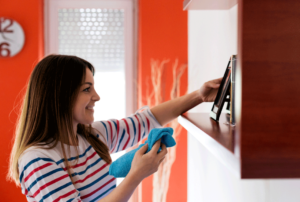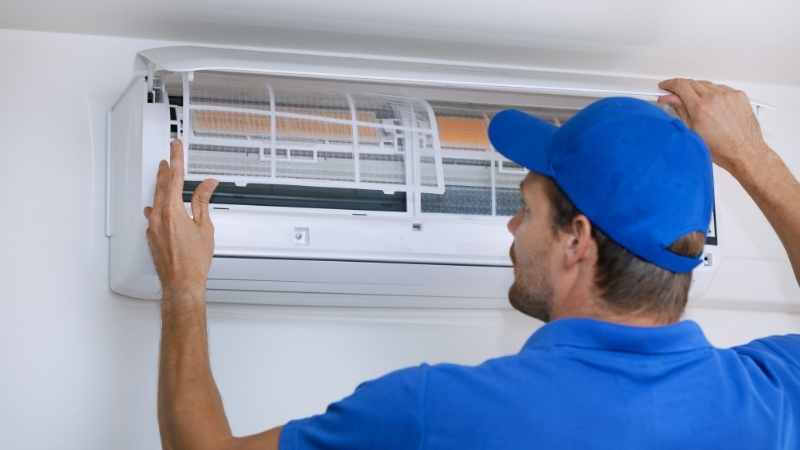How Often You Need to Dust for Optimal Health

Depending on a few factors, the answer fluctuates somewhat for each person and household. The one thing that everyone can agree on is that dusting on a regular basis may dramatically minimize the amount of time and energy spent keeping your house clean and allergen-free.
But do you need to dust every few days, every other week, once a month, every few months?
Gesundheit! Bless You!
Let’s explore the factors that determine your dusting schedule:
- Do you have a central air conditioning system in your home? If yes, how frequently do you clean or change the heating, ventilation and air conditioning (HVAC) filter? Allowing your HVAC filter to accumulate dust for an extended period of time between cleanings or replacements can increase the quantity of dust that circulates and settles in your house.
- If you live in a location where you can leave doors and windows open for a time to enable fresh air to circulate, this is a mixed blessing. Yes, fresh air is beneficial for air flow, but it may also carry unwelcome particles such as pollen, dust mites and other allergies. All of these factors can contribute to the quantity of dust that collects in your house, raising the sneeze factor—our bodies’ reaction to releasing irritants via our nose.
- Do you have dogs, cats and youngsters in your home? Dust amounts skyrocket with all these darling dependants.
It’s time to shine up a few recommendations now that the dust has settled and you’ve identified a few of the factors that might increase the quantity of dust in your home.
Vacuuming on a Regular Basis
With one exception, keeping a reasonably regular vacuuming routine will help minimize the quantity of dust in your home. However, if you don’t empty or change your vacuum bag or canisters after each usage, you can end up with more dust in the air. Vacuuming on a regular basis has the sole objective of reducing dust, not adding to it. If you smell an odour or start sneezing after vacuuming, it’s probably time to clean the canister, change the bags or replace the vacuum.
For dusting, use a damp cloth or Swiffer Duster
When dusting, use a moist cloth or a substance that will collect and keep the dust instead of releasing it into the air, where it will ultimately settle. The best method is to use a moist microfibre cloth. To avoid leaving wet spots or streaks on wood furniture, make sure the cloth is not too damp.
Swiffer dusters are also a great option that we recommend because they trap and lock up to 3 times more dust and allergens, compared to a traditional feather duster. Swiffer dusters contain 360 degrees of specially coated fibres that grab onto dust and don’t let go.
And work from Top to Bottom
Even with the best tools in your arsenal, there can still be dust that gets away and makes a mess in your home, especially if you “dust backwards.” To avoid this, start cleaning at the highest level—ceiling fans and overhead light fixtures. The dust that falls from these will be taken care of in your sweep of the lower-level items: Table lamps, coffee tables, end tables and finally your floors. Dust that falls from those spots will then be removed for good when you sweep, vacuum and mop.

Keep your HVAC filter and ducts cleaned on a regular basis
Maintaining a regular cleaning routine and keeping your HVAC filter clean can help to minimize the quantity of dust in the air, which will help to reduce the amount of debris that settles in your house. A High Efficiency Particulate Air filter will catch 99.97 percent of 0.3-micron particles, demonstrating that these filters are capable of trapping the majority, if not all, airborne particles. Installing one of these filters into your HVAC system can help to reduce dust significantly. Cleaning HVAC air ducts, in addition to cleaning and changing your HVAC filter, may drastically reduce airborne dust particles. It’s a good idea to have your air ducts cleaned and examined every spring and autumn to make sure they’re in good working order.
So, how often do I need to dust?
It’s truly an issue of personal health when it comes to dust frequency. It’s reasonable to state that the more often you dust, the less allergies there will be in our home. However, everyone’s reaction to their surroundings is unique. Allergy sufferers should dust more regularly, particularly during peak seasons. Begin by doing it once a week to observe how you react. Families with young children and pets are in the same boat. All of the activity raises the amount of dust, causing more dust to accumulate in a shorter period of time. If you don’t have allergies and don’t have children or pets, you can definitely reduce your dusting to once every two weeks, depending on your preferences.
Relax and take a deep breath
Although there are several health benefits to cleaning more often, dusting might also be a matter of look. The idea of hosting family, friends and guests in a dusty house makes many of us a little squirmy. We all want to live in a home that passes even the most stringent white-glove inspection. Unfortunately, not everyone has the time to dust as often as they should, but there is a workaround.
Get in touch with our team at Windsor Home Cleaning to handle the dusting—and the rest of your home as well—for a hassle-free, regular cleaning service. Our Residential Cleaning Technicians will help you get your house in order so you can relax.

